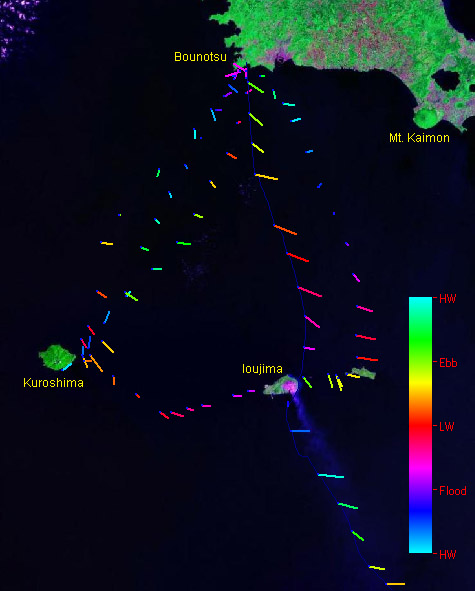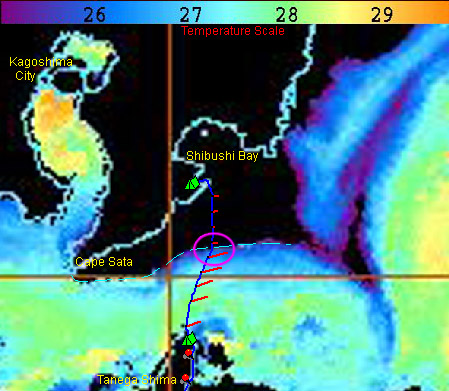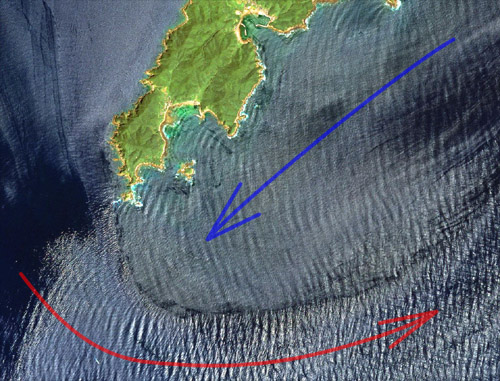Expedition Postprocessing 遠征処理

Finally, an overview map showing the whole expedition! The directions and speeds of the currents encountered constituted the expedition's main data; they are shown on the map coded with a color that corresponds to the phase of the local tide (see scale on left under the spider). Current speeds are coded at the same scale (in km/h) as the kilometer scale at the bottom of the map. As you can see, the fastest currents tended to be in the 6-7km/h range - fast enough to seriously interfere with the progress of a kayak. Flow directions are measured from the black dot located at each measurement site. You can see at a glance the tactics we used to deal with the strong cross-currents encountered during every long crossing on this trip. 遠征全体を現す地図。途中観測した流れのデータは、この遠征で得られた一番大切な情報でしょう。流れの印の色は、潮汐の位相を表す(参照キーは左側)。印の長さは、km尺と比べると流速を表す。早い時6-7kmの流れが有った。流れる方向は観察地点を表す黒い点から印の方向で表します。僕たちは流れに対してどのような作戦をやったのは、この地図の一覧ですぐ分かります。

The neighborhood of the Mishima Islands where we already visited twice before, warrants a closer look. A pattern emerges from the combined current measurements. In general, during ebb flow the currents tend to be strong and east-south-east-setting, while during flood conditions they are generally weaker and variable. This can be understood simply as a combination of a generally east-setting Kuroshio Current superimposed on a tidal current which in this area is known to set north-west on the flood, and south-east on the ebb. Looking at the data more closely, one may notice that the tidal pattern is delayed an hour or two compared to the tide itself. For example, at low tide the combined current is still east-setting and quite strong. 以前もう二回訪れた三島村の島々の付近での流れは、もうちょっと詳しく見よう。今まで集まったデータの全部を見ると、あるパターンがはっきり見えます。と言うのは、下げ潮の時、流れは東方向でかなり強くて、上げ潮の時、比較的に弱くて方向が変わりやすい。この現象は、黒潮の海流と潮流が重なっているからでしょう。この辺の黒潮は、普段に東へ流れます。潮流は満ち潮が北西へ、引き潮は南東へ流れます。その組み合わせの結果、観察した流れでしょう。もうちょっと細かく見たら、潮流が潮汐と比べて、数時間遅れているでしょう。なぜなら、例えば干潮の時、流れはまだまだ東へ、かなり強いで、余り引き潮の間と変わらない。

Looking at the Osumi Strait is also informative. Here, tidal currents seem to play a relatively minor role, and most of the observed flow seems to be due to the Kuroshio. Of interest is the sharp boundary of warm (Kuroshio) and cool (coastal Kyushu) waters, running down the center of Osumi Strait in this infra-red satellite image taken on July 22nd (probably the night before the eclipse, as it was still clear then). Temperature scale is on top; evidently the water near the Osumi coast is cooler than 25C and off the color scale. Circled in magenta is our own traverse of this boundary three days later. The drastic change in the measured current corresponds, not surprisingly, to the edge of the Kuroshio. The temperature difference was also felt on the skin of our hands. この大隈海峡の図も、ちょっと面白いでしょう。ここは、潮流は比較的に弱くて、主に観察する流れは黒潮の分でしょう。赤外線の衛星画像で得に目立ったのは、海峡の真ん中を走る暖かいと冷たい海水の境でした。(水温のキーは画像の上で、大隈側の水は25度以下だから黒になってしまいます。)マジェンタで表したのは、僕らがこの境を越えた地点。やはり、この辺で流れが突然弱めて、感覚でも海水が冷たくなったとその時気づいた。これで黒潮の端を乗り越えた。

In this closeup of Cape Sata(from the Japanese Yahoo Maps) you can clearly see the interaction of warm Kuroshio water (red arrow) and cold coastal water (blue arrow). If you are brave enough to go for a snorkel in these strong mixing current (the scenery is well worth it for those with sufficient ) you can feel this often drastic temperature difference on your own skin.
Next, we diverge into philosophy. Read at your own peril! 次はちょこっと哲学的な話。恥ずかしくて日本語に訳しない。
“I will choose a path that’s clear: I will choose free will.”
-Neil Peart, Rush, Permanent Waves
“The Earth is the only place in the universe that practices the myth of free will”
-Kurt Vonnegut, Slaughterhouse-Five
There was ample time to contemplate this, one of humankind’s most basic philosophical conundrums, during the long open-sea crossings of this kayak expedition. And a good reason too, since the chances of being able to successfully observe the total solar eclipse of July 22nd, the expedition’s ostensible goal, seemed vanishingly small even before Jogo and I began our paddle southward. The jet stream forecast for the day in question showed the most unfavorable situation imaginable. The weather forecasts most of us are used to concern themselves with conditions relatively close to the earth’s surface and quickly become completely meaningless if extrapolated more than a couple days into the future. Yet the jet stream, a powerful air current 10-15km above the earth, is ruled by physical laws at relatively longer time scales; its slow, serpentine movement can be predicted quite reliably for weeks in advance. Thus, by the 12th or so I already knew that on the day of the eclipse the jet stream would make a rather unseasonable meander to the south, positioning itself directly above the Tokara Islands where we planned to be watching. This would certainly bring bad weather to the area, including cloud that would obscure the eclipse and strong winds that we would have to fight in addition to the Kuroshio Current on the way down south. But by then the plan had been set, all arrangements had been made, and Jogo already bought his plane tickets. We seemed to be have no choice but to throw ouselves to the mercy of the elements, all for a sliver of a chance of success. The lyrics of Neil Peart, part of a loose philosophical foundation of my younger years (until ridiculed by an artist friend), were again being rebuked by the irrevocable subtleties of reality, even as Kurt Vonnegut’s seemingly whimsical vision of things rang true. Most of us think we regularly exercise our ‘free will’, feeling particularly satisfied if the choices we make are clear and easy, although in such cases little actual will seems to be required; in fact, in choosing obvious benefits, our actions seem all but predetermined. For example, if the weather been clear on our journey, I would not be writing about any dilemmas now. If, however, the choices to be made are subtle, when we feel the heavy presence of reality closing in, the scope of free will again diminishes: we can still make all kinds of choices, but since we have no idea which ones will turn out profitable, what good is our freedom? As for this expedition, there seemed to be no choice but to give in to the circumstances, to go and try to enjoy the experience. To echo the words of kayak guru Paul Caffyn, an expedition is, in miniature, a metaphor for life itself. Each trip brings a unique bouquet of trials, triumphs, and disappointments, and that is, after all, what it's all about. This one was no exception.
Perhaps because this was my first kayak expedition with a partner other than Leanne, everything was organized with even more diligence and attention to detail than usual. Also, more people than usual were involved, including Mr. Mori who gave us a lift to the starting point, and Mr. Mizuno of Water Field Kayaks who picked us up. Leanne was busy pretty well around the clock at home base in Amakusa, updating the blog daily and preparing and sending us weather information. Consequently, the trip ran with an almost professional level of smoothness. Jogo and I, though we barely knew each other, got along splendidly with not a single disagreement between us, even as we shared our opinions on a wide variety of subjects besides kayaking and navigation. When, after paddling for several hours into a fierce headwind at Yakushima, I suggested that we turn around and head for calmer conditions in the lee of the island, Jogo consented as if he had already made that decision an hour ago, though minutes before we were both struggling into the wind with iron determination and nary a thought of giving up. Days later, when making the difficult decision to make the final crossing with dodgy weather forecasted for each of the three days remaining to us, Jogo simply said he wanted to do it in the safest possible way, leaving the details to my expertise with weather analysis and forecasting on the Internet. This kind of conduct is only possible among people with considerable traveling experience, and a balanced outlook on the environment around them. I had found a great traveling partner and benefited considerably from his presence, learning about the value of virtues such as patience and the ability of being able to take things calmly and in stride.
As for the eclipse itself, when its time came and the heavily overcast sky grew quite dark for three inauspicious minutes, in spite of myself I could not prevent a bitter feeling of disappointment from filling my heart. This feeling persisted for much of the afternoon even as I heard on the radio that the eclipse was a complete writeoff on all the islands in the area; it wouldn't have helped had we gone wherever it was humanly possible to go in a kayak. But later that day on the bucolic Anbo River, watching a troupe of monkeys on the riverbank doing what monkeys do, the ill feeling gradually disippated, replaced again by the joy of moving upon the earth under one’s own power and for no particular reason. A tiny but authentic hot spring that evening, though seemingly redundant during the hot, humid summer, was crowded to capacity. And lo the hot water, though painful against my sunburned skin, imbued my psyche with healing and peace. As we embarked on the return leg of our journey the following day, the south sea with its strong currents and winds and the rocky shoals and shallows of its coasts, continued to fascinate as ever.
Labels: kayak expedition シーカヤック遠征


0 Comments:
Post a Comment
<< Home